Illegal Dumps on the Shore of the Tashkumyr Reservoir
Coordinates: 41.425131, 72.253401
The shore of the Tashkumyr Reservoir, where the local beach "Bachok" (tourist base Aisha) is located. A sunny spring morning, a cloudless sky, everything is blooming and bursting with life. However, this magnificent view is marred by large floating islands of dark brown garbage, which prevents the heavenly blue from reflecting in the water.
Several people in five inflatable boats, navigating around the contours of the garbage islands, approach the shore, where they are met by fellow villagers with questions: "Did you find it?". But without answering the questions, as if on command, they barely set foot on land and began to vomit under the trees. It turned out that they had inhaled the stench of the corpses of floating animals.
These are fishermen from the village of Razan-Sai, located upstream of the Naryn River, who were searching for a villager who had drowned a week ago. They were trapped among huge islands of garbage formed by spring floods, mudflows, and decaying corpses of large and small livestock.
Environmental Problem
Every year, especially during the spring floods and mudflows, the corpses of domestic animals—donkeys, horses, cows, small cattle, and birds—end up in the reservoir. Like inflated huge balloons, they drift in the waters of the Tashkumyr Reservoir. Additionally, the wind from the Bishkek-Osh highway carries all the garbage (plastic and glass bottles, canisters, rubber, etc.) that is thrown from cars into the reservoir. The shores and bays are littered with rotting household and industrial waste, which floats thickly on the water's surface. Some of it settles in the bays and along the shores, overgrown with reeds and thickets, decomposing, and when the water level rises, it re-enters the reservoir. All of this pollutes and poisons the drinking water consumed by the residents of the Fergana Valley and downstream of the Naryn River. From the tourist base "Aisha" (which locals call the beach "Bachok"), one can visibly see the floating icebergs of garbage; it is located at 444 km of the Bishkek-Osh road, on the gentle shore of the Tashkumyr Reservoir of the Tashkumyr HPP, where the Naryn and Kara-Suu rivers merge (Aksy district), 7 km from the city of Tash-Kumyr. The length of the reservoir is 20 km, and its maximum width is about 500 meters, making it quite suitable for small tourist navigation.
Historical Reference: The Tash-Kumyr HPP was built in 1985 at the confluence of the Kara-Suu River (Aksy district) and the Naryn River, downstream from the Kurp-Sai HPP. The reservoir of the hydroelectric station stretches along the Bishkek-Osh road from 427 to 447 km. The surface area of the water mirror is 7.8 sq. km, with a length of 20 km. The width ranges from 100 to 500 meters. The water volume is 144 million cubic meters. The Naryn River is transboundary and provides drinking freshwater for the populations of Kyrgyzstan, Uzbekistan, Tajikistan, and Southern Kazakhstan (Chymkent and Kyzylorda regions and the Baikonur Cosmodrome). The reservoir serves as a reservoir for irrigation and drinking water. About 20 million people use it for domestic needs.
Since the establishment of the Tash-Kumyr HPP (1985), no state agency has cleaned the water area, except for the power station, which uses a stationary crane on the dam crest to lift garbage to prevent it from entering the turbines. There are no settlements around the reservoir; the right bank (Aksy district) is completely alienated and inaccessible. It is literally littered with the skeletons of decaying large and small livestock. The left bank is located 80-100 km away from the district center. Legally, the water belongs to the Ministry of Agriculture of the Kyrgyz Republic, but it does not engage in the cleaning and maintenance of the reservoir. The reservoir is territorially part of the Aksy and Nooken districts. However, these districts also do not engage in cleaning the water surface. As the saying goes, "with seven nannies, the child is blind." The tourist base "Aisha" is the only company that cleans the garbage in its adjacent territory, located on the left bank of the reservoir. It occupies an area of 5 hectares of coastal land, where it receives local and foreign tourists during the summer period and grows a garden. Sometimes floating animal corpses and garbage settle in its coastal zone, emitting a foul smell and frightening people. It has repeatedly appealed to the authorities and state agencies; the environmental inspection of the Nooken district, the central office in Bishkek, the Ministry of Emergency Situations, and others. But all in vain. For many years, no one has addressed the problem. The staff of the tourist base clean the coastal water surface, approximately 600 meters long, with their motorboat.
According to S. Baisabaeva, the deputy director of the tourist base, they have repeatedly appealed to NGOs, USAID for grants, and the government for assistance and proposals. If no state agency in Kyrgyzstan cleans the Tashkumyr Reservoir from garbage and monitors the ecological situation, then the tourist base, with its enthusiasm, can take on this task if provided with a small vessel. For this purpose, they requested a grant of about $15,000 to $20,000 for the purchase of a Soviet (Russian) manufactured boat, 12-15 meters long, with a carrying capacity of 3-5 tons. The grant project budget included: the purchase and transportation of a small vessel from Russia to Tashkumyr, the construction of a pier, the installation of a light crane "crane" on it, and equipment for catching and lifting garbage from the water's surface, as well as staff training. Waste disposal. Organization of boat tours with garbage collection and removal...
Additionally, the tourist base "Aisha" has been proposing for many years the organization of an international ecological project—a rafting expedition on kayaks and catamarans from the sources of the Naryn River, from the glaciers of the Tien Shan to the Aral Sea, involving teams from Central Asian states, biologists, ichthyologists, ecologists, tourists, and mass media. This would include studying the fauna and flora, the fish population of the Naryn River, water resources, and the impact of man-made dams of HPPs on the region's ecosystem... But no one has yet responded to this project.
Unfortunately, neither the state nor grant providers have voiced support for the reasonable and beneficial proposal, formally citing a lack of funds. What a pity... If the state or grant provider allocated a grant once, it would ensure a favorable ecological situation in the reservoir for years, keeping the water clean for more than 20 million people downstream of the Naryn River (Syr Darya).
In words, the authorities and governments understand that fresh and clean drinking water is extremely necessary and vital for people. Their life and health directly depend on ecology and water resources. However, in reality and actions, this is not the case, until an ecological disaster occurs somewhere.
The tourist base "Aisha" intends to appeal to the Presidents and governments of Central Asian states—Kyrgyzstan, Uzbekistan, Kazakhstan, Tajikistan, and Turkmenistan—to draw their attention to the ecological and drinking water problem in the Tashkumyr Reservoir.
Captions for the photos:
Huge islands of garbage and animal corpses near the tourist base "Aisha," years of accumulated garbage on the shores of the reservoir.
Floating garbage near the tourist base "Aisha"
The beach's coastal zone is cleaned and garbage is removed by the staff of the tourist base and children on their motorboat.
Author: Zheenaly Kambaraliev, journalist. City of Tash-Kumyr
The shore of the Tashkumyr Reservoir, where the local beach "Bachok" (tourist base Aisha) is located. A sunny spring morning, a cloudless sky, everything is blooming and bursting with life. However, this magnificent view is marred by large floating islands of dark brown garbage, which prevents the heavenly blue from reflecting in the water.
Several people in five inflatable boats, navigating around the contours of the garbage islands, approach the shore, where they are met by fellow villagers with questions: "Did you find it?". But without answering the questions, as if on command, they barely set foot on land and began to vomit under the trees. It turned out that they had inhaled the stench of the corpses of floating animals.
These are fishermen from the village of Razan-Sai, located upstream of the Naryn River, who were searching for a villager who had drowned a week ago. They were trapped among huge islands of garbage formed by spring floods, mudflows, and decaying corpses of large and small livestock.
Environmental Problem
Every year, especially during the spring floods and mudflows, the corpses of domestic animals—donkeys, horses, cows, small cattle, and birds—end up in the reservoir. Like inflated huge balloons, they drift in the waters of the Tashkumyr Reservoir. Additionally, the wind from the Bishkek-Osh highway carries all the garbage (plastic and glass bottles, canisters, rubber, etc.) that is thrown from cars into the reservoir. The shores and bays are littered with rotting household and industrial waste, which floats thickly on the water's surface. Some of it settles in the bays and along the shores, overgrown with reeds and thickets, decomposing, and when the water level rises, it re-enters the reservoir. All of this pollutes and poisons the drinking water consumed by the residents of the Fergana Valley and downstream of the Naryn River. From the tourist base "Aisha" (which locals call the beach "Bachok"), one can visibly see the floating icebergs of garbage; it is located at 444 km of the Bishkek-Osh road, on the gentle shore of the Tashkumyr Reservoir of the Tashkumyr HPP, where the Naryn and Kara-Suu rivers merge (Aksy district), 7 km from the city of Tash-Kumyr. The length of the reservoir is 20 km, and its maximum width is about 500 meters, making it quite suitable for small tourist navigation.
Historical Reference: The Tash-Kumyr HPP was built in 1985 at the confluence of the Kara-Suu River (Aksy district) and the Naryn River, downstream from the Kurp-Sai HPP. The reservoir of the hydroelectric station stretches along the Bishkek-Osh road from 427 to 447 km. The surface area of the water mirror is 7.8 sq. km, with a length of 20 km. The width ranges from 100 to 500 meters. The water volume is 144 million cubic meters. The Naryn River is transboundary and provides drinking freshwater for the populations of Kyrgyzstan, Uzbekistan, Tajikistan, and Southern Kazakhstan (Chymkent and Kyzylorda regions and the Baikonur Cosmodrome). The reservoir serves as a reservoir for irrigation and drinking water. About 20 million people use it for domestic needs.
Since the establishment of the Tash-Kumyr HPP (1985), no state agency has cleaned the water area, except for the power station, which uses a stationary crane on the dam crest to lift garbage to prevent it from entering the turbines. There are no settlements around the reservoir; the right bank (Aksy district) is completely alienated and inaccessible. It is literally littered with the skeletons of decaying large and small livestock. The left bank is located 80-100 km away from the district center. Legally, the water belongs to the Ministry of Agriculture of the Kyrgyz Republic, but it does not engage in the cleaning and maintenance of the reservoir. The reservoir is territorially part of the Aksy and Nooken districts. However, these districts also do not engage in cleaning the water surface. As the saying goes, "with seven nannies, the child is blind." The tourist base "Aisha" is the only company that cleans the garbage in its adjacent territory, located on the left bank of the reservoir. It occupies an area of 5 hectares of coastal land, where it receives local and foreign tourists during the summer period and grows a garden. Sometimes floating animal corpses and garbage settle in its coastal zone, emitting a foul smell and frightening people. It has repeatedly appealed to the authorities and state agencies; the environmental inspection of the Nooken district, the central office in Bishkek, the Ministry of Emergency Situations, and others. But all in vain. For many years, no one has addressed the problem. The staff of the tourist base clean the coastal water surface, approximately 600 meters long, with their motorboat.
According to S. Baisabaeva, the deputy director of the tourist base, they have repeatedly appealed to NGOs, USAID for grants, and the government for assistance and proposals. If no state agency in Kyrgyzstan cleans the Tashkumyr Reservoir from garbage and monitors the ecological situation, then the tourist base, with its enthusiasm, can take on this task if provided with a small vessel. For this purpose, they requested a grant of about $15,000 to $20,000 for the purchase of a Soviet (Russian) manufactured boat, 12-15 meters long, with a carrying capacity of 3-5 tons. The grant project budget included: the purchase and transportation of a small vessel from Russia to Tashkumyr, the construction of a pier, the installation of a light crane "crane" on it, and equipment for catching and lifting garbage from the water's surface, as well as staff training. Waste disposal. Organization of boat tours with garbage collection and removal...
Additionally, the tourist base "Aisha" has been proposing for many years the organization of an international ecological project—a rafting expedition on kayaks and catamarans from the sources of the Naryn River, from the glaciers of the Tien Shan to the Aral Sea, involving teams from Central Asian states, biologists, ichthyologists, ecologists, tourists, and mass media. This would include studying the fauna and flora, the fish population of the Naryn River, water resources, and the impact of man-made dams of HPPs on the region's ecosystem... But no one has yet responded to this project.
Unfortunately, neither the state nor grant providers have voiced support for the reasonable and beneficial proposal, formally citing a lack of funds. What a pity... If the state or grant provider allocated a grant once, it would ensure a favorable ecological situation in the reservoir for years, keeping the water clean for more than 20 million people downstream of the Naryn River (Syr Darya).
In words, the authorities and governments understand that fresh and clean drinking water is extremely necessary and vital for people. Their life and health directly depend on ecology and water resources. However, in reality and actions, this is not the case, until an ecological disaster occurs somewhere.
The tourist base "Aisha" intends to appeal to the Presidents and governments of Central Asian states—Kyrgyzstan, Uzbekistan, Kazakhstan, Tajikistan, and Turkmenistan—to draw their attention to the ecological and drinking water problem in the Tashkumyr Reservoir.
Captions for the photos:
Huge islands of garbage and animal corpses near the tourist base "Aisha," years of accumulated garbage on the shores of the reservoir.
Floating garbage near the tourist base "Aisha"
The beach's coastal zone is cleaned and garbage is removed by the staff of the tourist base and children on their motorboat.
Author: Zheenaly Kambaraliev, journalist. City of Tash-Kumyr



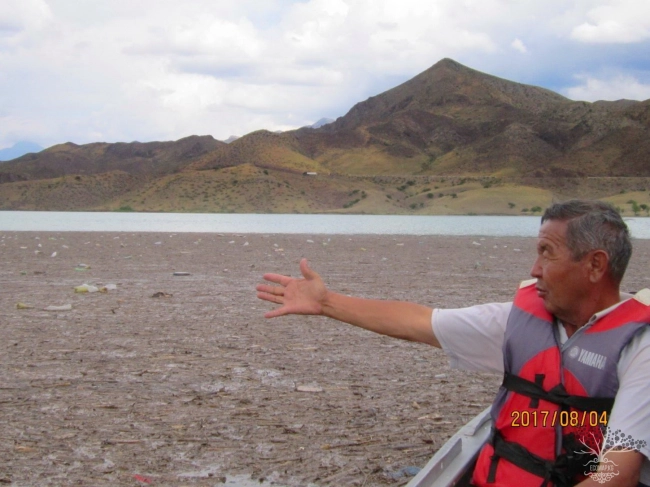
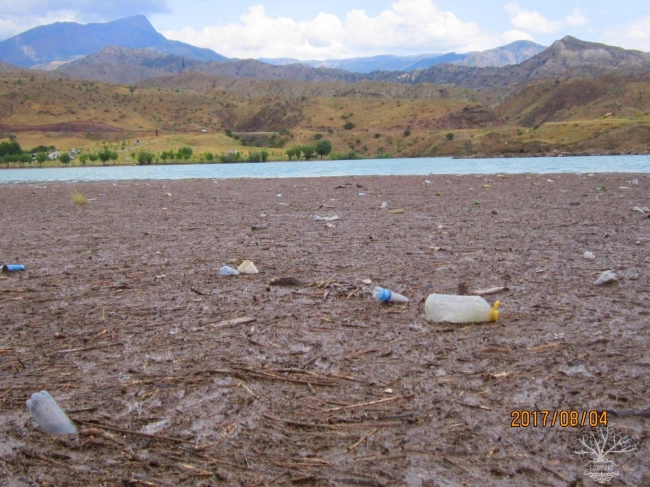
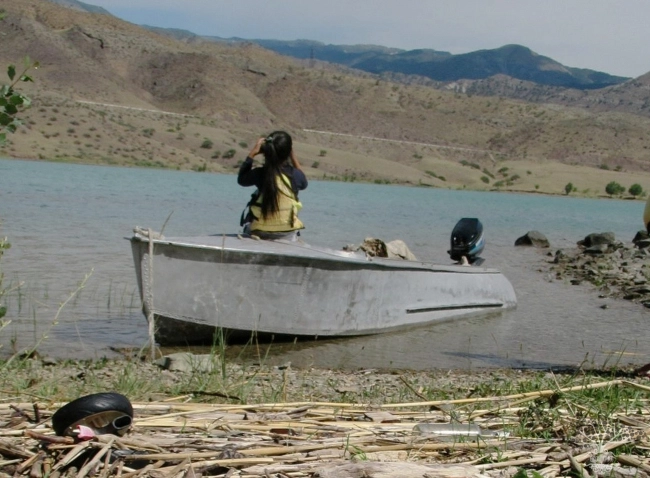
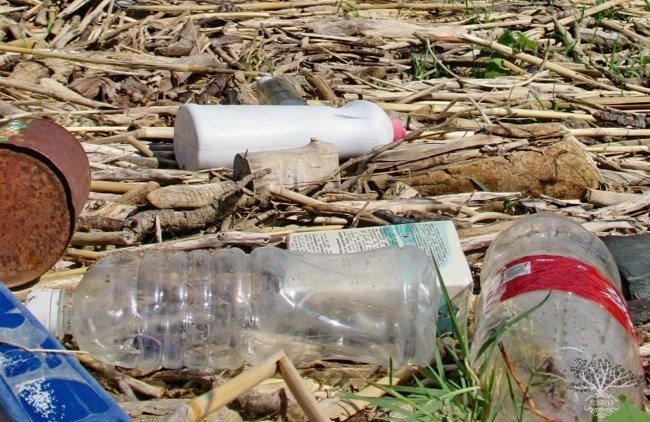
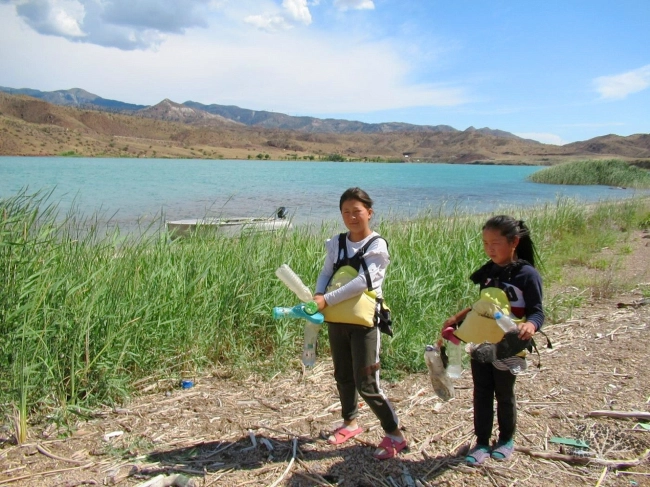
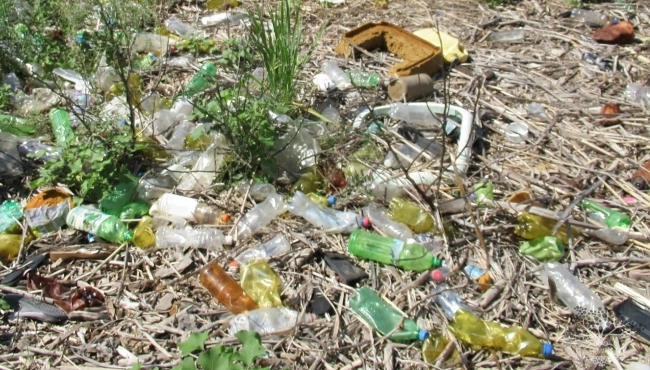
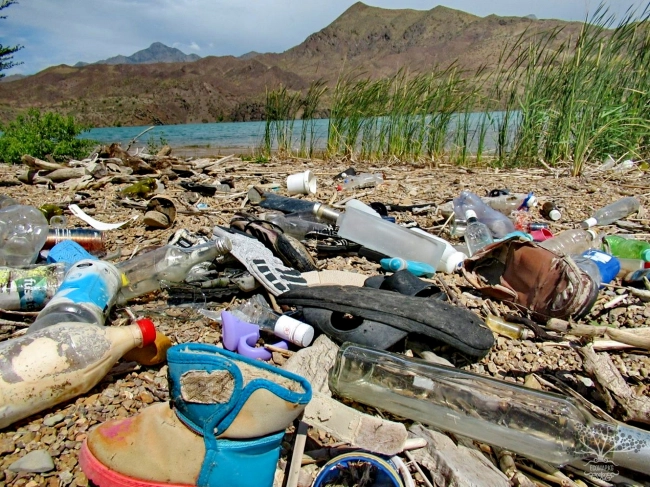


















Attention: Information based on submitted complaints